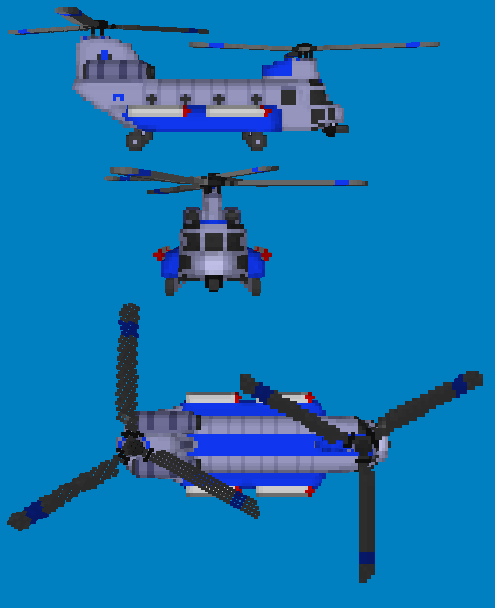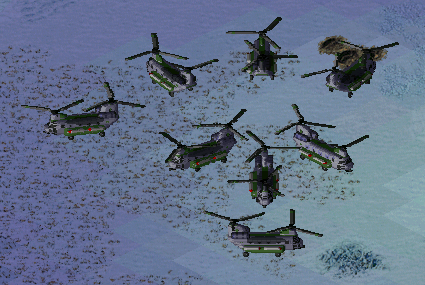

SSIA Air Transport:
Cost: 1600
Armor: Light
Speed: Fast
Weapon: 5mm Minigun
50mm Rockets
Range: Short
Medium
Factory Tech, Infantry/Light Vehicle transport, low-tier anti-surface unit
The SSIA Air Transport (VTOL Mk V) is a rotary wing aircraft designed to ferry small vehicles and infantry. Built under license from the American company Boeing, the Air Transport VTOL Mk V is a modified CH-47 Chinook. This design decision was made because of the blueprints for the VTOL Mk IV Air Transport never made it through the time transfers.
Such losses did not stop engineers from taking the relatively modest Chinook helicopter and turning it into an aircraft worthy of service within SSIA divisions. The first changes included a remaking of the entire air-frame with a light-weight composite armor that added enough protection to resist up to 40mm cannon hits awhile increasing the overall weight of the helicopter by less than 25%. The next set of changes involved the installing of several minor weapons systems to the aircraft. Two rocket tubes, each with 10 50mm armor piercing rockets each provide the VTOL Mk V with a limited capacity against armored targets- although training for usage of the helicopter explicitly states that no pilot should even consider using these weapons offensively.
SSIA engineers however, were aware of the short-comings of such small weapons, especially against infantry; even a 90mm, 100mm AP rocket would be largely useless on infantry- thus, a nose-mounted 5mm minigun was added to all VTOL Mk Vs, giving the aircraft the ability to cut down unprotected infantry safely and quickly before deploying onboard units.
This typical SSIA outlook on equipment- how much damage it can cause and how much damage it can take, isn't the entire picture for the VTOL Mk V Air Transport, though. The Mk V replaces the dual engines of the CH-47 with more powerful versions designed to carry the additional bulk of the composite armor, 5mm rounds and 50mm 'Stinger' guided rockets and extra fuel. Perhaps the strangest thing about the VTOL Mk V is that despite these changes, it only slightly differs in outward appearance to the Chinook. If it wasn't for the distinctive paint-job of Air Transport, confusion between it and the CH-47 would be widespread.
Service records on the VTOL Mk V are limited, but initial battlefield reports show that the combination of armor and firepower present in the aircraft allowed for it to make landings under fire and safely extract before critical damage is sustained. This is an excerpt from a pilot's log late 2019. "We proceeded to LZ Bravo; encountered 2 XD-3s on the way, the 5mm dispatched them easy. Systems report 90% frame armor. Rest of approach was unopposed, men from the 4th successfully deployed at the LZ. Before clearing op-area, had to participate in defense of the 4th's position: we used all of our stingers, but the enemy turned back."
Voxel Notes:
Shadow is rendered on top of aircraft for some odd reason, the gaps in the rotor blades are caused by the use of an older HVA Builder.
Variants:
Mk I- First model of the VTOL series, was a rotary-wing aircraft. Unarmed.
Mk II- Upgraded Mk I using jump-jet system
Mk III- New chassis, incredibly heavily armored, but unarmed and too slow for proper service.
Mk IV- New chassis, heavily armored, equipped with 5mm Minigun and 50mm Rocket pods. Uses jump-jet system.
STOL series- Much larger cargo-plane equivalents.



